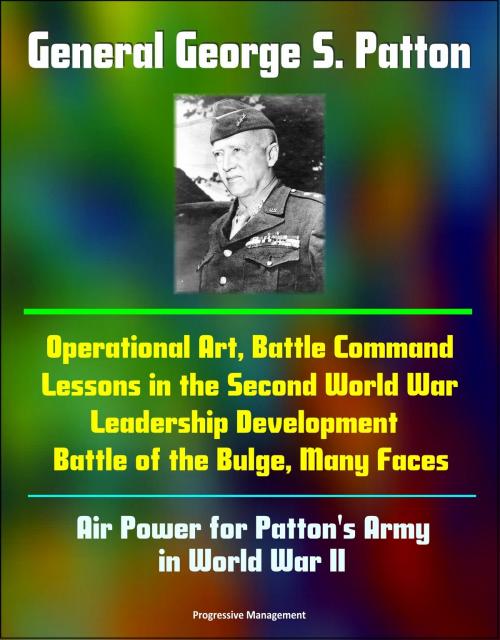General George S. Patton: Operational Art, Battle Command Lessons in the Second World War, Leadership Development, Battle of the Bulge, Many Faces, Air Power for Patton's Army in World War II
Nonfiction, History, Military, United States, World War II| Author: | Progressive Management | ISBN: | 9781311096333 |
| Publisher: | Progressive Management | Publication: | October 5, 2014 |
| Imprint: | Smashwords Edition | Language: | English |
| Author: | Progressive Management |
| ISBN: | 9781311096333 |
| Publisher: | Progressive Management |
| Publication: | October 5, 2014 |
| Imprint: | Smashwords Edition |
| Language: | English |
Six official documents provide a unique perspective on the life and work of World War II general George S. Patton:
Part One: The Operational Art as Practiced by General George Patton, Jr. During the Battle of the Bulge * Part Two: General George S. Patton, Jr.: Master of Operational Battle Command, What Lasting Battle Command Lessons Can We Learn from Him? * Part Three: The Leadership Development of Dwight D. Eisenhower and George S. Patton Jr. * Part Four: Comrades in Arms: The Influence of George S. Patton on Walton H. Walker's Pusan Perimeter Defense * Part Five: Air Power for Patton's Army - The XIX Tactical Air Command in the Second World War * Part Six: The Many Faces of George S. Patton, Jr.
"He had many faces, many contrasting qualities. A noted horseman, a well-known swordsman, a competent sailor and navigator, an airplane pilot, a dedicated athlete and sportsman, he was also an amateur poet, and sixteen of his articles were published in magazines. Rough and tough, he was also thoughtful and sentimental. Unpredictable, he was at the same time dependable. He was outgoing, yet anguished. A complex and paradoxical figure, he was a man of many faces. He is remembered best for the unique leadership he exercised. He had the ability to obtain the utmost from American troops, and some would say that he obtained more than the maximum response. Through his charisma, exemplified by a flamboyant and well-publicized image, he stimulated American troops to an aggressive desire to close with and destroy the enemy. He personified the offensive spirit, the ruthless drive, the will for victory in battle." The Many Faces of George S. Patton, Jr.
As part of the Allied Campaign in the European Theater of Operations, the Battle of the Bulge was an Allied counterattack against a major German counteroffensive into the Ardennes. Although best known for individual and tactical unit actions, the Battle of the Bulge was primarily successful because the Allied Commanders, especially Patton, applied operational thinking to the planning and execution of the operation. The operational art as practiced by Patton during this operation has significant implications to the contemporary military since the counterattack planning and execution was completed in a crisis situation. The lessons learned from Patton's planning and execution is still applicable today and in the future for crisis operations. Therefore, this study focuses on Patton's actions. The Battle of the Bulge exemplifies the importance the practice of the operational art plays in linking tactical actions to strategic objectives as an Allied failure would have had strategical implications. The Allied chain of command clearly understood the operational objectives and correctly judged the enemy's center of gravity. Patton was able to achieve those objectives by early planning. This early planning was the result of effectively utilizing intelligence in his areas of interest to anticipate the German counteroffensive. He further demonstrated remarkable agility in turning his Army 90-degrees to attack. This agility, combined with speed of maneuver, resulted in a surprised enemy. Of paramount importance is the fact that this speed of maneuver included not only combat and combat support units, but also combat service support units. Although reluctant to maintain operational reserves, Patton exhibited his prowess in conducting combined and joint operations. Finally, Patton's use of operational fires was instrumental in the successful execution of the Battle of the Bulge.
Six official documents provide a unique perspective on the life and work of World War II general George S. Patton:
Part One: The Operational Art as Practiced by General George Patton, Jr. During the Battle of the Bulge * Part Two: General George S. Patton, Jr.: Master of Operational Battle Command, What Lasting Battle Command Lessons Can We Learn from Him? * Part Three: The Leadership Development of Dwight D. Eisenhower and George S. Patton Jr. * Part Four: Comrades in Arms: The Influence of George S. Patton on Walton H. Walker's Pusan Perimeter Defense * Part Five: Air Power for Patton's Army - The XIX Tactical Air Command in the Second World War * Part Six: The Many Faces of George S. Patton, Jr.
"He had many faces, many contrasting qualities. A noted horseman, a well-known swordsman, a competent sailor and navigator, an airplane pilot, a dedicated athlete and sportsman, he was also an amateur poet, and sixteen of his articles were published in magazines. Rough and tough, he was also thoughtful and sentimental. Unpredictable, he was at the same time dependable. He was outgoing, yet anguished. A complex and paradoxical figure, he was a man of many faces. He is remembered best for the unique leadership he exercised. He had the ability to obtain the utmost from American troops, and some would say that he obtained more than the maximum response. Through his charisma, exemplified by a flamboyant and well-publicized image, he stimulated American troops to an aggressive desire to close with and destroy the enemy. He personified the offensive spirit, the ruthless drive, the will for victory in battle." The Many Faces of George S. Patton, Jr.
As part of the Allied Campaign in the European Theater of Operations, the Battle of the Bulge was an Allied counterattack against a major German counteroffensive into the Ardennes. Although best known for individual and tactical unit actions, the Battle of the Bulge was primarily successful because the Allied Commanders, especially Patton, applied operational thinking to the planning and execution of the operation. The operational art as practiced by Patton during this operation has significant implications to the contemporary military since the counterattack planning and execution was completed in a crisis situation. The lessons learned from Patton's planning and execution is still applicable today and in the future for crisis operations. Therefore, this study focuses on Patton's actions. The Battle of the Bulge exemplifies the importance the practice of the operational art plays in linking tactical actions to strategic objectives as an Allied failure would have had strategical implications. The Allied chain of command clearly understood the operational objectives and correctly judged the enemy's center of gravity. Patton was able to achieve those objectives by early planning. This early planning was the result of effectively utilizing intelligence in his areas of interest to anticipate the German counteroffensive. He further demonstrated remarkable agility in turning his Army 90-degrees to attack. This agility, combined with speed of maneuver, resulted in a surprised enemy. Of paramount importance is the fact that this speed of maneuver included not only combat and combat support units, but also combat service support units. Although reluctant to maintain operational reserves, Patton exhibited his prowess in conducting combined and joint operations. Finally, Patton's use of operational fires was instrumental in the successful execution of the Battle of the Bulge.















